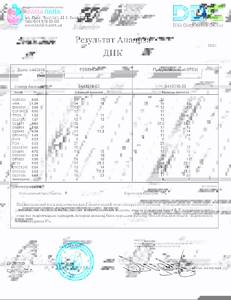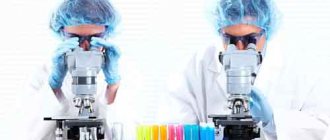DNA is a special technique aimed at establishing family relationships (most often paternity). Studies show that 10% of men raise children born from other men in marriage.
There can be many reasons for taking the test, for example, the father’s doubts or moving abroad for permanent residence. In any case, the relevant question is how much DNA is done for paternity? The timing depends on various circumstances.
Content
- Dependence of the speed of obtaining results on DNA analysis methods
- Is it possible to speed up a DNA test?
Anyone planning to undergo genetic testing is wondering how long it takes to do a DNA test?
There is no clear answer to this question. The timing of DNA analysis depends on the type of study and the number of markers analyzed (tandem repeats). It also matters where exactly the test is performed - on site or sent to another laboratory. In the second case, part of the time is spent on delivering biological material. For example, if we are talking about the study of ethnic origin on the mother’s side, DNA analysis can take more than a month; establishing paternity takes from 4 to 9 days.
But, as a rule, most DNA tests are completed in 7-9 business days.
Non-standard samples
Non-standard samples, such as fingernails, hair, and blood stains, can be used for paternity testing. This makes it possible not to resort to a more explicit procedure. List of non-standard materials
Such samples should only be used for participants who do not have access to oral swabs. Although we are able to isolate DNA in most cases, we do not guarantee these materials. In the case of DNA extraction, the accuracy is as high as with standard materials.
Dependence of the speed of obtaining results on DNA analysis methods
Since DNA testing is a very promising industry, genetic analysis methods are constantly being improved. But despite scientific progress, it still remains a very complex procedure.
In order to “read” a deoxyribonucleic acid molecule, it:
- isolated from the obtained biological material;
- divided into parts, which are painted with fluorescent dyes with different luminescence intensities;
- amplify (repeatedly copy areas that are taken for analysis).
After this, the selected genome regions are analyzed.
The speed of performing these procedures depends on the chosen technique. Currently, sequencing (building DNA structure) is carried out in several ways. The most promising and fastest is automated sequencing using the Sanger method, as well as the new nanopore sequencing technique, somewhat reminiscent of computed tomography.
Paternity test for court or embassy
If the analysis is needed for the courts of the USA, Europe and other countries, you can do a legal analysis.
In case the analysis is required for use in an embassy or court, identification of the individual is required. To do this, you must take with you for each participant: a passport or birth certificate of the participants.
It is possible to carry out such an analysis remotely; we are given sealed samples with a protocol for collecting the material. Legal analysis procedure
Is it possible to speed up a DNA test?
As we have already mentioned, how much a DNA test is done depends on the type of research being carried out. But the equipment of the laboratory and the methodology used also play an important role in this process. Therefore, the deadlines indicated by different companies offering genetic research can sometimes differ significantly.
When choosing a laboratory for genetic research, it is better to focus not on the speed of obtaining results, but on the reputation of the company offering such a service. After all, the most important thing is the reliability of DNA analysis.
Our team compiles genetic passports and guarantees high accuracy of the results obtained. Sign up for a DNA test with us to find out everything about the characteristics of your body.
DNA test for maternity (mother, child)
A DNA maternity test will determine whether the alleged mother is the child's biological mother. To determine maternity, experts analyze DNA samples from the baby and the mother, isolate the DNA profile of each, and compare them for common genetic markers.
DNA maternity testing is useful in the following situations, including:
- When an adopted child and birth mother, who have been reunited after separation, want to confirm their biological relationship.
- When a mother who planned to have a child through in vitro fertilization wants to confirm that she was implanted with the correct embryo.
- When the family or hospital staff fears that the baby has been mixed up in the hospital by mistake
Father's DNA samples are not mandatory for the test - motherhood can be determined with a fairly high degree of probability without them. As a result of a DNA test to determine maternity, you receive a conclusion with one of the following conclusions: positive - not excluded as a mother (probability 99.9+% -99.99999%), or negative - excluded as a mother (maternity is 100% excluded).
DNA Test Sister/Brother
The Sister/Brother DNA test allows you to determine whether there is a family relationship between the test takers. Experts analyze DNA samples from each test participant, isolate each person's DNA profile, and compare them for common genetic markers.
This DNA test reveals the statistical probability of whether a brother/sister shares common parents or not. The cost of the test includes two participants, but you can add other participants, such as another sibling.
This test is indispensable when it is not possible to take genetic material from the child’s parents, and allows you to confirm paternity and maternity by an indirect method.
Parental participation (mother or father) is recommended for this test if possible. However, if it is not possible to obtain samples from the parents, a test may still be possible. Testing samples from at least one parent greatly increases the accuracy of this test and is recommended whenever possible. If this is not possible, it is recommended to provide information on whether the common parent is the mother or the father to improve accuracy.
Unlike a DNA paternity test, which always gives a definitive result, in this test the laboratory calculates a relationship index. If the relatedness index is below 1.00, this means there is no relationship. If the relatedness index is above 1.00, it means that it is most likely that the test takers are related. The higher the relatedness index value, the higher the likelihood that the test takers are biological brothers/sisters.
To analyze the likelihood that siblings have only one parent in common rather than two, a half-relatedness index is calculated. The ratio of the half relatedness index to the full relatedness index infers whether siblings share one common parent (for example, only the mother) or both common parents (the mother and the putative father).
At what age can the test be done?
It is possible to take an analysis of DNA molecules not only from a newborn baby, but even from a child in the womb, starting from the ninth week of pregnancy. This was possible 10 years ago, but then the amniocentesis procedure was performed. The woman's abdominal wall and uterus were punctured to obtain a sample of amniotic fluid. Nowadays, everything has become simpler: laboratories can isolate a child’s DNA from the mother’s blood. A pregnant woman just needs to take a blood test from a vein. Not all laboratories carry out such a test, since the result may be decisive for saving the baby’s life.
Since DNA does not change during life, there are no age restrictions. Some men in old age check their kinship with their already graying children.
How is biomaterial delivered?
The test requires biomaterial samples from both the alleged father and the child. A DNA sample from the mother may also be required to eliminate the possibility of random matches and thus increase the accuracy of the analysis. Suitable biomaterials include saliva, blood, semen, nails, hair, toothbrush, chewing gum, cigarette butts, and even earwax. DNA is found in almost all cells of our body. The simplest and most common option is a sample of buccal epithelium, that is, cells of the mucous membrane of the inner surface of the cheek. To do this, you just need to move a cotton swab in your mouth for 10 seconds.
In some cases, laboratories offer a service such as remote sampling of biomaterial. In this way, residents of settlements that do not have laboratories can conduct the test. On the laboratory’s website, the client orders a kit for taking samples of biomaterial for DNA analysis, and it also describes in detail how to correctly collect the sample. The person seals the cotton swabs and mails them back to the laboratory. In this case, it is very important to be careful and never touch the sticks with your bare hands. This may affect the accuracy of the analysis. Of course, the result of a “home test” will not have any legal force.
Twins
There are two types of twins - identical and fraternal. Identical twins occur when a fertilized egg divides and each daughter cell gives rise to a separate organism. Identical twins are always of only one sex and are genetically almost identical. Fraternal twins can be of the same or different sexes and will have significant differences in their DNA structure. Using advanced molecular genetic technology, we are able to determine with 100% accuracy whether two twins are identical or fraternal. For analysis, DNA samples of two persons who are in an alleged blood relationship are required.
Who pays for genetic testing?
When preparing a case to establish paternity for a court hearing and during the proceedings, the court has the right, taking into account the opinions of the parties involved and the circumstances of the case, to decide to order an examination. Her conclusion about the origin of the child, taking into account the results of the test conducted using the “genetic fingerprinting” method, is considered one of the evidence in the case and must be assessed by the judge in conjunction with other materials.
In a situation where a DNA test confirms paternity, the court's decision will establish the child's origin from the father. The party in whose favor the decision is made is awarded compensation from the defendant for all legal expenses incurred . That is, if the examination was carried out at the request of the plaintiff, for example, the mother, and she paid for the test, then all her expenses should be compensated by the father, but on the condition that the examination confirms his blood relationship with the child.
If the claim is partially satisfied, costs may be awarded in proportion to the amount of claims satisfied by the court, and to the other party, accordingly, in proportion to the share of claims that were denied to the applicant.
Cost of the procedure
It is impossible to unambiguously answer the question of how much it costs to carry out a particular procedure, since everything depends on the individual conditions and circumstances of the case. The cost of DNA testing also depends on a number of factors. The pricing policy is structured in such a way that the cost of the service is regulated taking into account the location of the customer, as well as the conditions for obtaining the necessary material. On average, the cost of the service starts from 9,000 rubles.
In addition, the customer must understand that the final cost will depend on what additional factors will affect the study.
For example, if an urgent examination is required, you will have to pay extra for efficiency, and if a forensic examination is ordered, then the cost will average 3,000-5,000 rubles, which is much more expensive than a procedure carried out by voluntary agreement of the parties.
Areas of application
Forensic scientists were the first to appreciate all the advantages of the then young and undeveloped DNA testing technique. And, this was not without a coincidence. The discovery of DNA identification, similar to fingerprint identification, was discovered by British scientist Alec Jeffreys on September 10, 1984. He was studying abnormalities in chromosomal DNA using X-rays, and noticed that nucleotides have a unique sequence and it differs for everyone.
The discovery gave rise to the variety of applications of DNA analysis that exist today - we can observe how incredible technology from science fiction becomes everyday reality. It's surprising that Alec Jeffries never won a Nobel Prize. He still lives in the UK and is 69 years old.
These days, with a DNA test you can:
- Establish a person’s identity by his smallest traces: by the glass from which he drank; a drop of blood dried on a shirt, etc.
- Establish paternity.
- Establish relationship and its degree between an unlimited number of people (without studying the DNA of fathers and mothers).
- Identify an infection or virus before the first symptoms of the disease appear.
- Create a diet that is most suitable for the body, based on its innate individual characteristics.
- Predict predisposition and contraindications to sports and physical activity.
- Find out whether there are traces of hereditary diseases and predisposition to them in the genome.
- Find out the sex of the child even before his birth, as well as the Rh factor and genetic failures (if any).
And this is only from the range of possible applications available to the general public. In the future, genetic scientists hope to find the secret, if not of eternal life, then to develop a method to extend it many times over.
How is forensic examination carried out?
If a DNA test was ordered as part of a trial, it must be carried out in accordance with a strict procedure. The algorithm is as follows:
- in court, a medical expert uses special instruments to collect the necessary material. Moreover, the samples are in different containers and transferred to a special center for subsequent analysis;
- Payment for the analysis is made after it has been carried out using a regular receipt at any banking institution. Some centers and laboratories provide special discounts on payment for such services;
- the research is carried out within the prescribed period, and then the result of the research is submitted to the court;
- Based on the results obtained, the court makes a final decision.

It should be noted that the possible results of the analysis are:
- positive with a result of 99.9%;
- negative – 100%.
Decoding the received data
Decoding the data involves painstakingly comparing the position of genes and their shape with a database of standards. This reveals how a gene behaves and what consequences its individual activity and activity in conjunction with other genes leads to.
Transcription takes longer than other stages of analysis.
Diagnosis of diseases
Probably the most useful and promising area of genetic research for people is the diagnosis of diseases in the early stages, and even earlier. Today testing allows:
- Identify variable genes. This is when the person himself is not susceptible to the disease, but can pass it on to the next generation.
- Determine cell wear and tear - cellular aging. The main factor that affects the ability of a cell to divide is the length of the telomeres inside it. With each subsequent division, the telomeres become a little shorter, and so on until the cell loses the ability to divide. There are ways that allow you to lengthen telomeres and thereby prolong your youth.
- Conduct an analysis of your general health to create an individual diet and exercise schedule. Testing allows you to identify allergens and contraindications.
- Identify predisposition to the most dangerous and common disease of the millennium, and carry out preventive measures.
Kinship
The most popular DNA test among ordinary people is paternity testing. It is not uncommon for single mothers to resort to him in order to bring their father to justice and force him to pay child support. It happens that a positive research result gives the right to claim an inheritance.
But the research possibilities are not limited to this:
- Sibling test - allows you to identify the relationship and its degree (direct, first cousin, second cousin, etc.) between potential brothers and sisters. Testing often touches on subtle issues of family relationships and forbidden connections.
- An indirect paternity test, or genetic reconstruction, allows one to identify family ties from the side of the father, without the father himself.
- Establishment of Paternity. Sometimes, if circumstances require it, then motherhood.
- And even tests for twins that reveal which twins are heterozygous or monozygous. This can be important, for example, when deciding on organ donation.









